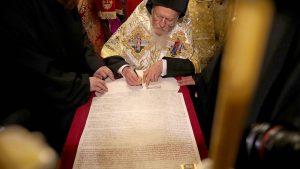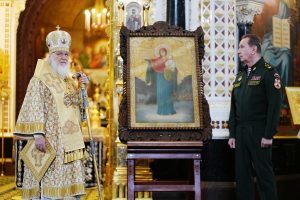
Jerry G. Pankhurst is professor emeritus of sociology and of Russian and Central Eurasian studies at Wittenberg University.
From its first phase starting in the Euromaidan protests and the “Revolution of Dignity” of 2014 to the present calamitous phase, the war in Ukraine has precipitated a deep review of the state of Eastern Orthodoxy among theologians and among secular scholars who understand the societal impact of religion as well as the personal influence of one’s own faith.
In one sense, the war in Ukraine is a symptom of problems endemic to Eastern Orthodoxy; in some measure, the war is only possible against the backdrop of these broader problems. On the other hand, given the free actions of Russian Patriarch Kirill and others in leadership in the Russian Orthodox Church, the war is also a cause of the current manifestation of these problems across the Orthodox world.
This reassessment of Orthodoxy, seeking reform, has had four major problematic dimensions.
(1) Endemic Jurisdictional Conflict. The conferral of autocephalous status by the Patriarch of Constantinople, Bartholomew, through his Tomos delivered to Ukrainian churchmen in January 2019 against the will of the Patriarch of Moscow and all Rus’, Kirill, brought to a boil the deep conflict among the patriarchates that make up the Orthodox communion. At center stage is the relative power and prestige of the Patriarchates of Constantinople and Moscow.

Divisive issues of jurisdictional control in the complex globalized world have brought into focus the overall problem of linking the church structures of Orthodoxy to ethno-national identities. These issues are especially acute among diaspora groups that have been created by the out-migration of Orthodox people to various places in the world as they seek freedom and opportunity. In the Ukrainian case, however, one historically Orthodox population has been invaded by another historically Orthodox power in a most cruel way. It is only ecclesiastical boundaries that divide them in the first instance. How can it be that these Orthodoxies can be so at odds that one can cruelly attack another with military violence? How is it possible that Russia and Ukraine, two so closely connected Slavic nations, are in deadly combat? How is it that Russia can define Ukrainian nationality as the evil “other?” Does some flaw in the global ethno-national structure exist here that requires repair?
(2) Church-State Collaboration. Based in the ethno-national structure of the church, the symbiosis between the Putin regime and the Moscow Patriarchate indicates that this structure has problems of church-state collaboration, often seen before and elsewhere, that are not healthy for religious life. Well before Ukraine’s 2014 EuroMaidan “Revolution of Dignity” when Russia illegally annexed Crimea and sponsored the occupation of the Donbas region in eastern Ukraine by rebellious forces, the Russian Orthodox Church (ROC) was providing self-serving religious legitimizing narratives for the power manipulations of the Putin regime. Following the advice of Machiavelli to his prince, the ROC permitted Putin to always “appear [to be] . . . a religious man. And there is nothing so important as to seem to have this last quality.” [1]
Putin has used this narrative of religious self-identification to argue in favor of the right to attack Ukraine and take Ukraine for Russia, it being part of the “Russian World” or the mystical “Holy Russia.” In that sense, the Russian Orthodox legitimation of Putin’s rule and interpretation of the role of greater Russia is part of the cause for the Ukraine war.
Patriarch Kirill and the ROC are not simply passive facilitators in this regard. Kirill and his church leadership have concretely articulated the modern Russian imperial vision in their denunciations of the Ukrainian religious scene and condemnations of the autocephalous Orthodox Church of Ukraine (OCU). They also demonstrate this imperial vision in their support for the Russian military not just as a defensive force but as an aggressive, conquering force.

(3) Fundamentalism and Ethnodoxy. A long-simmering problem for Eastern Orthodoxy in many places and jurisdictions is that of “fundamentalism.” This fundamentalism demands strict adherence to the putative rules of Christianity, which require obeisance to hierarchical leadership that is steeped in “Tradition” allegedly inherited from the ancient Fathers of the Church and the Ecumenical Councils. But this fundamentalism is usually distilled to the theology of “repetition and praises” [2] without capturing the spiritual needs of modern people.
One church leader describes the “episcopolatry” [3] that has devolved into worship of form—adulation of pageantry led by bishops—but that avoids the movement of the spirit and Christian mission. Furthermore, fundamentalism rejects ecumenical relations, even among closely related groups, and is often supported by what sociologists have dubbed “ethnodoxy: a collectively held belief system that rigidly links a group’s ethnic identity to its dominant faith” and supports a culture of intolerance. [4] (Note the link with point 1 above.)
(4) Morality and the Orthodoxy of War. The behavior and preaching of the Patriarch of Moscow in support of the invasion of Ukraine has been nearly universally condemned by Christian leaders around the world, excluding only those who have a prior alliance with Patriarch Kirill. Alongside the foreign affairs of the Russian Federation, the Russian Church under Kirill’s leadership has pursued an expansionist agenda that steps on the prerogatives of other Orthodox leaders and apes—or sometimes prefigures—the policies of the Russian government itself.
We can see that within the internal workings of Orthodoxy there are important problems of moral obligations and responsibilities. But above all, the very stance of the leaders of the Russian Church as unequivocally on the side of the aggressor war maker in Ukraine raises the basic issue of the church’s moral status, the supposed protector and promoter of morality in society.
The Russian Church is on a moral crusade of sorts advocating “traditional values” in family relations, anti-LGBTQ policies, and similar matters [5] that can be seen as within the sphere of religion no matter one’s specific stance on the social issues. But advocacy of the war against Ukraine and of the vicious attacks by Russian forces, without any significant pushback for peace, points to the church’s own message of immorality.
Most Orthodox churches have few explicitly stated moral doctrines as such, and they rely on teaching the scriptures and lives of saints to provide what guidance is needed in this regard. In 2000, however, the Russian Orthodox Church, led by Kirill when he was head of the Department of External Church Relations of the Moscow Patriarchate, created an important statement of doctrine on moral matters. The Basis of the Social Concept demands that the Russian Orthodox Church call upon the “powers that be” to seek a just and quick peace.
The Russian Orthodox Church seeks to carry out her peace service both on national and international scale, trying to help resolve various contradictions and bring nations, ethnic groups, governments and political forces to harmony. To this end, she makes appeals to the powers that be and other influential sections of society and takes efforts to organise negotiations between hostile parties and to give aid to those who suffer. The Church also opposes the propaganda of war and violence, as well as various manifestations of hatred capable of provoking fratricidal clashes. [6]
Patriarch Kirill has not “called upon” Putin to end the invasion of Ukraine or to stop the broader war to take over Ukraine. And Kirill seems to be a master, not a condemner, of the “propaganda of war and violence.” The Patriarch’s own words condemn him and also demand others to answer how this could be the behavior of a major Christian leader.
This outline represents a description of problems of Orthodoxy that the war of Russia against Ukraine has brought to prominence. This war is a catalyst for the current expansion of the debate on these issues within global Orthodoxy. The horrors of war should stimulate a sense of urgency for authentic and creative resolution.
[1] Niccolò Michiavelli, The Prince 58 (George Bull trans., Penguin Books 2003) (1961).
[2] Pantelis Kalaitzidis, The ‘Kairos’ of the Late Metropolitan of Pergamon John D. Zizioulas, Pub. Orthodoxy (16 Feb. 2023) (translation of eulogy given by Kalaitzidis at the funeral of Metropolitan Zizioulas, 4 February 2023).
[3] John A. Jillions, Episcopolatry, Pub. Orthodoxy (27 Oct. 2022).
[4] Vyacheslav Karpov, Elena Lisovskaya & David Barry, Ethnodoxy: How Popular Ideologies Fuse Religious and Ethnic Identities, 51 J. for Sci. Study Religion 638, 638 (2012).
[5] Kristina Stoeckl & Dmitry Uzlaner, The Moralist International: Russia in the Globalist Culture Wars (2022).
[6] Russ. Orthodox Church, War and Peace, in The Basis of the Social Concept at chap. VIII.
